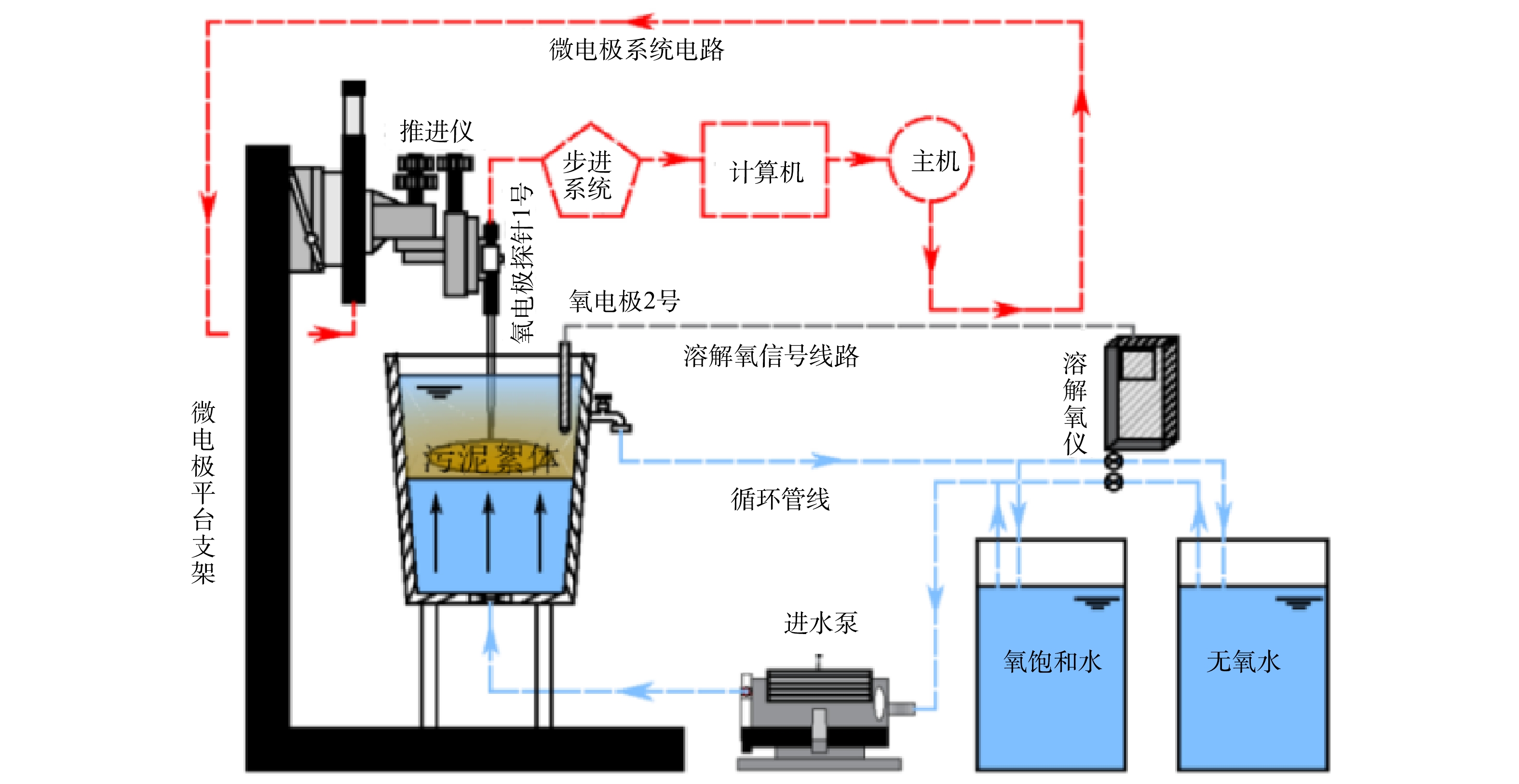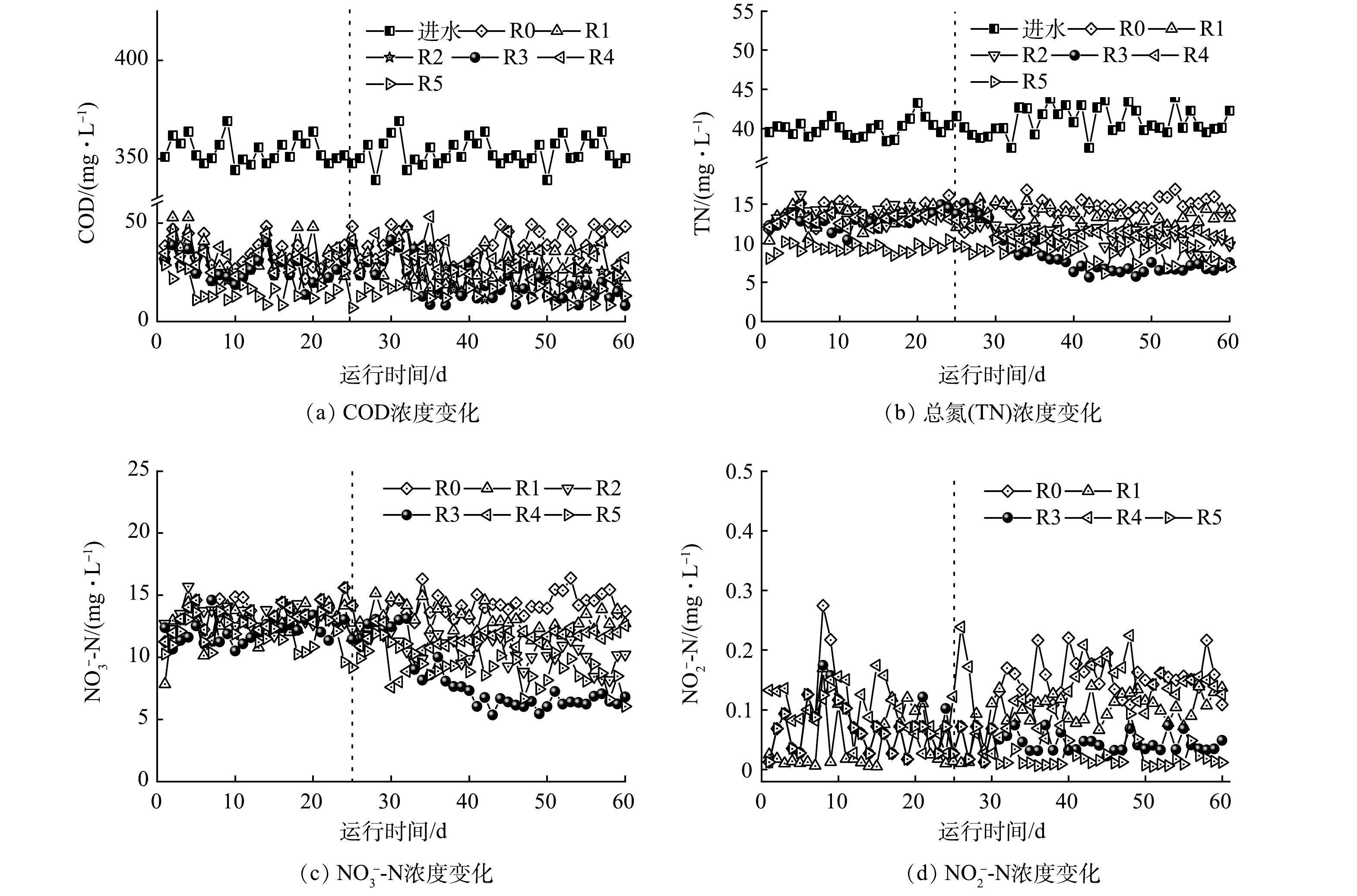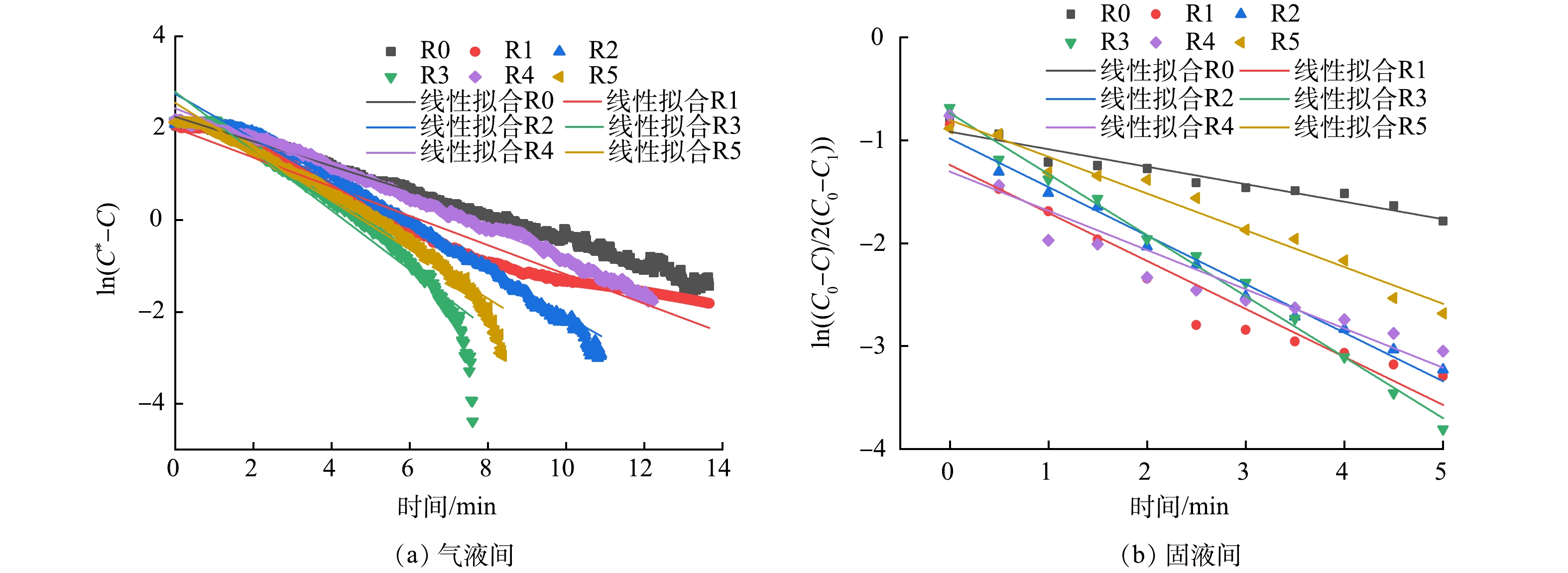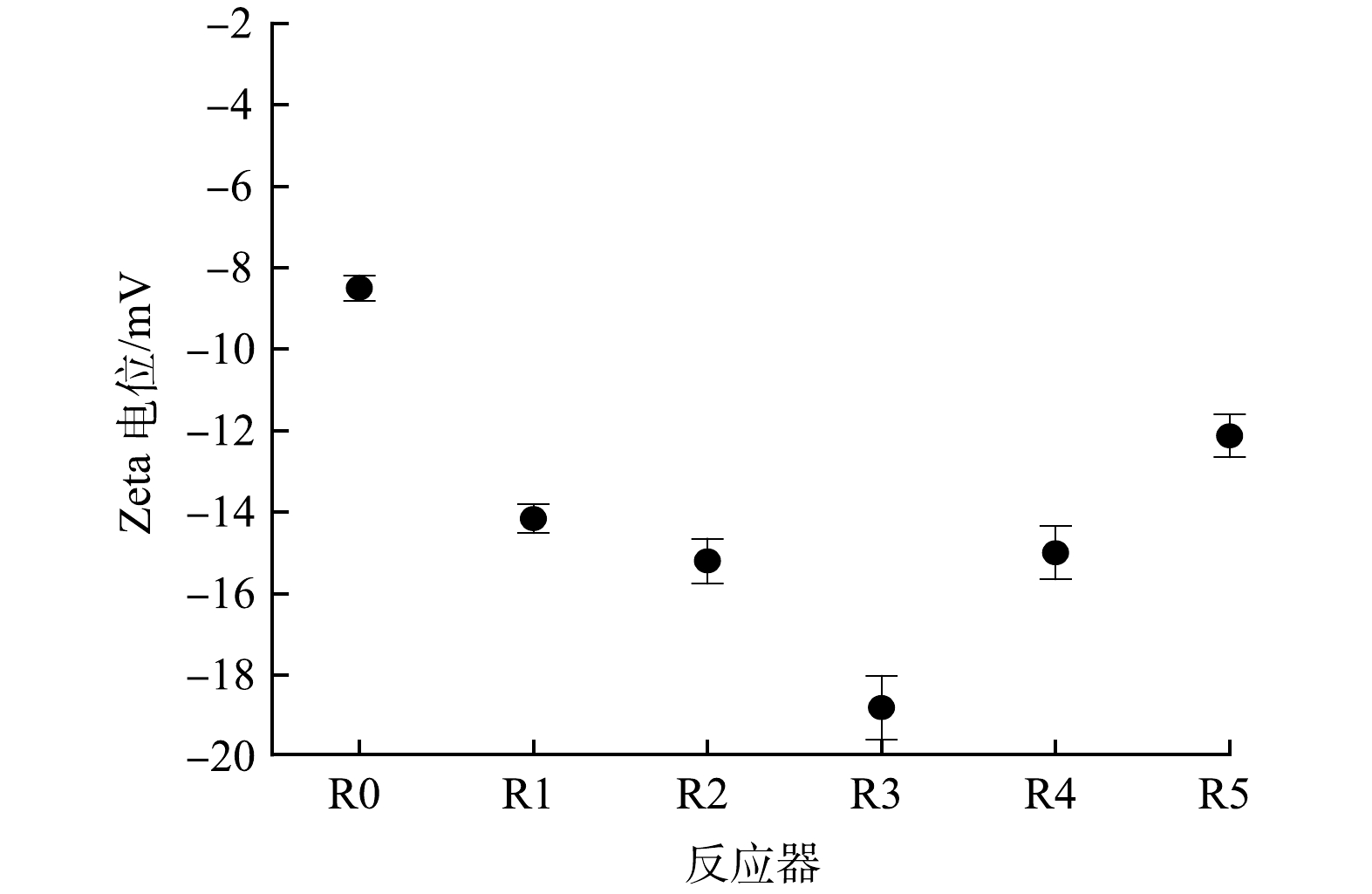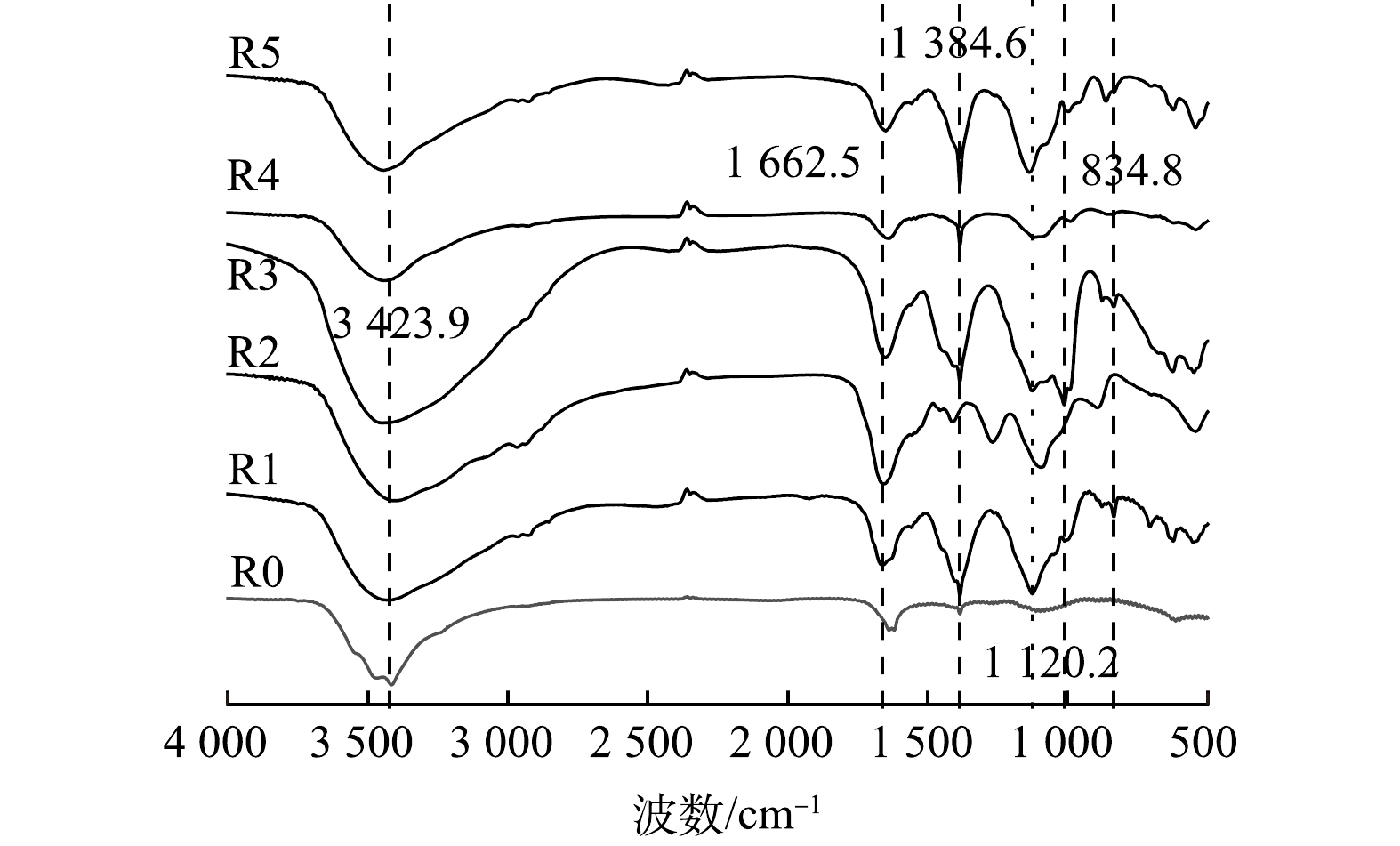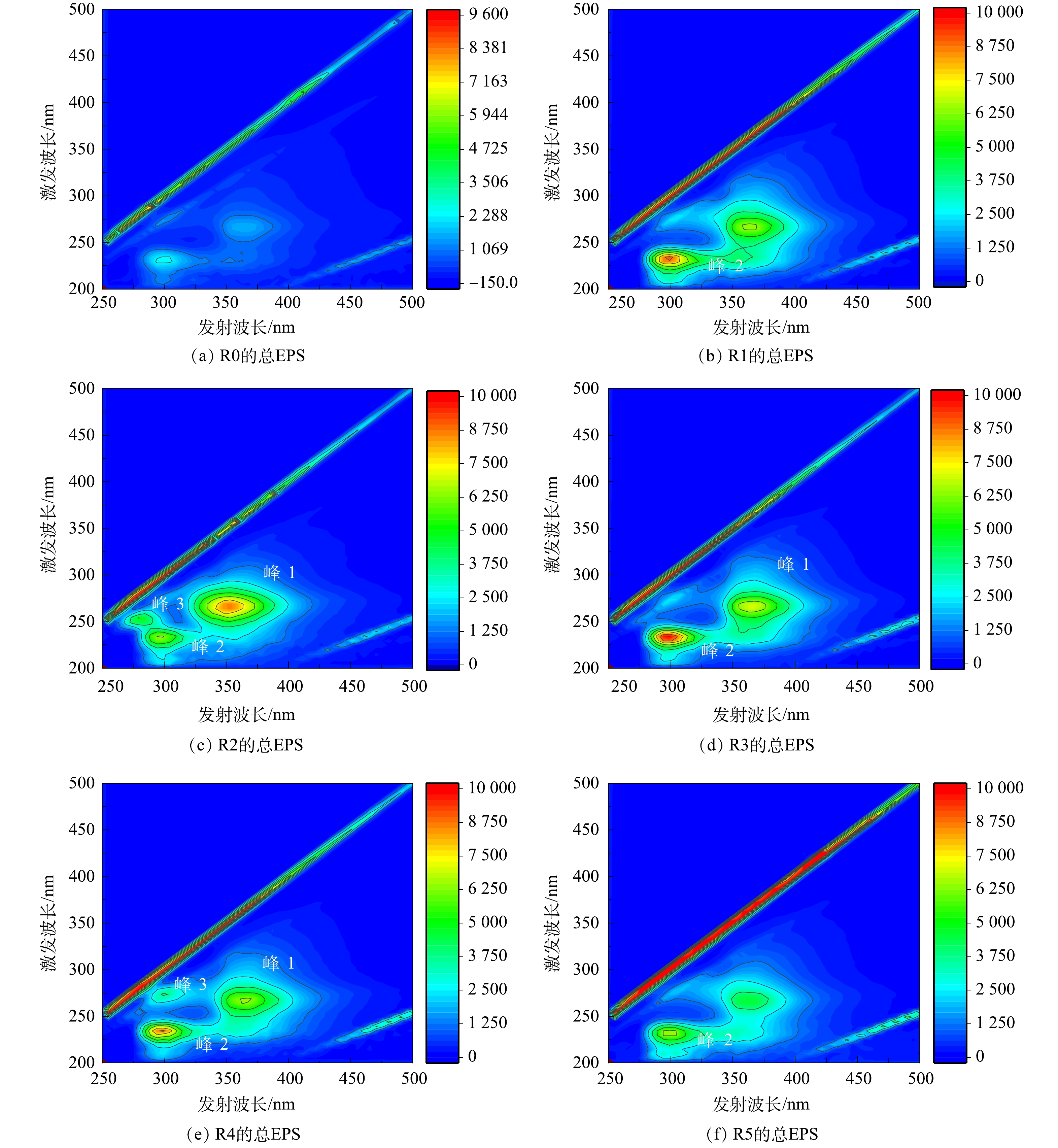-
污水处理行业一直以来是一个高能耗行业,物质的传递效率较低是造成污水处理能耗居高不下的重要因素之一[1]。由于氧气和其他污染物质的传质效率较低,使得传统污水处理工艺不得不采用过量曝气,而这一过程的能耗占污水处理厂所用电力的50%~80%[2]。因此,能否利用自然界普遍存在的某种能量来打破物质传递阻力,提高物质在气-液-固三相间的传质效率,对提升污水处理效能也许是一种新的思路。
在活性污泥系统中,氧的传质的过程主要包含氧分子(O2)在液相中的传递,再由液相扩散至固相2个路径[1]。在液相中,传递效率主要依赖于液相的流态特征,如紊流程度和液体的黏滞性等;而在液相与污泥絮体间的传递效率的提升则取决于能否打破固液之间形成的双膜[3]。一些学者通过优化曝气策略,达到降低曝气量的目的。例如FAN等发现当采用低曝气量时(DO低至0.3 mg·L−1) ,活性污泥系统仍能达到正常曝气时的出水水质[4],然而这将导致气-液间超过50%的传质系数损失和丝状菌型污泥膨胀,不利于反应系统的稳定运行[5]。此外,也有研究通过改变曝气方式来提高氧的利用效率[6]。然而,这些方式因为并未改变氧气在气-固-液间的传质效率,同时也增加了运营管理成本而未得到广泛应用。部分学者开展了改变流态特征来提升传质系数的相关研究,取得了一些成果,如YAN等则通过增加水中机械剪切力来改变氧的传质效率[7]。尽管加载高能耗的机械搅拌能提高气液间传质效率,但所产生的剪切力极易破碎絮体,导致污泥功能性失活[8-9]。因此,需要一种既能提高氧在三相间的传质效率,又能避免破坏活性污泥理化特性的低能耗技术。
振动是一种普遍存在于自然环境中的能量传递方式。有研究表明,在不同的介质表面会产生微观状态下的剪切面,可以延长空气在水中的行程,为氧的传递提供良好的传质动力学环境[10-12]。振动在水体中会形成为微涡流,有利于活性污泥絮体内外间的物质交换[12]。此外,低频率机械振动(low frequency mechanical vibrations,LFMVs)能够抑制丝状菌的膨胀,有利于生物反应器内污泥保持良好的沉降性[13]。故而,从理论上分析,振源与水体的耦合作用对提高活性污泥系统的去除效能具有良好的效果[14]。然而,目前关于振动对污水中氧及污染物质传递效率的作用机制尚不明确。因此,本研究提出在低DO条件下,LFMVs在活性污泥系统中形成紊流流态继而强化物质更好的进入活性污泥絮体这一理念,探究了LFMVs对物质在多相流系统中输移的作用机制,揭示了在此条件下氧由气相至液相,再由液相进入絮体内部的传质机理,获得了絮体物理结构特性对振动条件的响应关系。本研究成果将为废水处理的节能降耗提供新的思路,有助于我国“双碳”战略的实施。
-
实验装置采用6组完全相同的AO反应器。如图1所示,反应器由储水池、AO反应池和二沉池组成。缺氧池和好氧池的HRT分别为2.80 h和9.10 h。反应器总体积为100.8 L,工作体积为78.75 L。其中,缺氧池18.8 L,好氧池60.0 L,二沉池15.8 L。振源由12 V直流起振器(R-370CE,Xin Yongtai,China)、变频器(CCM6Ds,Xin Yongtai,China)和交流电转化器(R370,Xin Yongtai,China)组成,最大振动频率60Hz,振动频率为10~60 Hz,振动量3.4 g。振源分为3组,每组2个起振器,分别置于缺氧池1组和好氧池2组。
各反应器在158.4 L·d−1的恒定进水流量下运行60 d。水质平稳期25 d,实验期35 d。运行时,内回流180%,外回流80%,污泥停留时间15 d,DO为(1.2±0.30) mg·L−1。水温应控制在(20.0±1.0) ℃。有研究[15]表明,地面背景的振动频率约为20~60 Hz。因此,本研究振动频率设定为低振幅机械振动,10、20、40和60 Hz不同频率分别对应荷载于反应器R1、R2、R3、R4,此外,R0为无振动空白组,R5为正常曝气(维持DO≥2 mg·L−1)下的作为经济性评价的对照组。因为各反应器中的初始污泥一致,系统及所含的活性污泥性质完全相同。因此,研究的重点和取样测试均选在各反应器加载不同频率LFMVs稳定运行的末期。
-
实验用接种污泥来自重庆某城市污水处理厂,模拟污水中含有350.00 mg·L−1COD、40.00 mg·L−1 NH4+-N、5.00 mg·L−1 PO43--P。研究中使用的合成废水包括23.10 mg·L−1 醋酸钠和16.50 mg·L−1葡萄糖(COD的贡献率为1:1)、153.00 mg·L−1 NH4Cl、44.00 mg·L−1 KH2PO4、90 mg·L−1 MgSO3、24 mg·L−1 NaHCO3、14 mg·L−1 CaCl2和0.40 mL微量元素溶液。微量元素溶液的成分与ZHENG等使用的成分相同[16]。
-
1)气-液相体积总传质系数。如图2所示,容器内加入适量营养液,保持500.00 mg·L−1 COD、40.00 mg·L−1 NH4+-N及适量的微量元素。开始测量之前,按照每去除1.00 mg O2需要投加7.90 mg Na2SO3脱氧剂的比例去除泥水混合液中的DO,按照维持容器内钴离子在0.05~0.5 mg·L−1投加催化剂CoCL2。然后开始曝气,在20 ℃的水温、2.00 L·min−1的气体流速下快速实现复氧,利用溶解氧仪(HQ30d, HACH, 美国)记录此过程中的溶解氧变化,直至溶解氧浓度达到饱和值。体积总传质系数为气液传质系数(KL)和气液接触面积(a)的组合(根据式(1)计算[4])。,用于定量的描述气液氧气交换过程中的传质能力[17-18]。
式中:C为反应器中的O2浓度,mg·L−1;t为时间,min;KLa为体积总传质系数,min−1;C*为稳定态DO的饱和浓度,mg·L−1。因此,所得数据以t为横坐标,ln(C*-C)对数值为纵坐标,所得拟合直线的斜率绝对值即为KLa。此过程反复3次,求平均值即为总体积传质系数。
2)固-液相扩散系数测试装置。如图2所示,采用溶解氧微电极(DO-50, Unisense,Denmark),电极穿刺主要使用一台万向显微镜(Szx16,Olympus, Japan)观察操作器,以20 μm的空间分辨率微调电极尖端的位置,在絮体中心插入1个溶解氧微电极(1号),在絮凝物外部同一水平放置另1个相同的溶解氧微电极(2号);为了避免因氧电极位置的差异造成结果误差,反应器通过底部引入向上均匀流,以保证反应器中同一水平处的液体含氧量一致。同时,根据实验需要,利用双进水阀门控制氧饱和的蒸馏水和含氮气无氧蒸馏水之间的切换。此外,电极(1号)穿刺絮体的位置即液面下3~6 cm处设置尼龙网圈(网圈3个方向以细绳固定,悬停于液面中央)以保证测试期间絮体浓度和位置的稳定。测试样本取值各反应器荷载LFMVs驯化稳定的最后一天的活性污泥。测试前,饱和水在絮凝物上流动30 min,然后迅速将进水切换为脱氧水,持续5 min。在这一阶段之后,再将进水换为饱和水。重复该过程,利用微电机测试平台记录溶解氧信号,以获得瞬态和稳态值。按污泥絮体中心的氧浓度随时间的变化可以近似如式(2)所示[19]。
式中:C0、C1为絮体表面溶液中溶解氧的稳定值(由氧电极(2号)测得),mg·L−1;C为絮体中心电极测得DO动态变化值,mg·L−1;Π为圆周率;d为活性污泥平均粒径(由粒径分布测得),μm。在上升阶段,C0为低DO值,C1为高DO值;在下降阶段,C0为高DO值,C1为低DO值。通过该曲线斜率
$ -\dfrac{4{\Pi }^{2}{D}_{\text{app}}}{{d}^{2}} $ 即可求出Dapp的值。氧扩散系数(Dapp)可以准确的描述液相中的DO转移至活性污泥核心点位的效率[20]。 -
因为各反应器中的初始污泥均接种于同一污水厂,污泥性质相同。因此,测试样品均在实验周期最后两天内取得,并进行对比分析。具体污泥理化特性表征方法如下:
1)粒径分布与Zeta电位。污泥粒径和污泥表面Zeta电位则通过旋涡仪将10 mL污泥均匀混合,然后根据制造商的协议,使用Marlvern计数器(Mastersizaer 3000,Malvern Panalytic,UK)测得污泥悬浮液中污泥的平均粒径。使用Zetasizer 3000(Malvern,UK)测量每个样品的Zeta电位[21]。
2)胞外聚合物的提取与测定。活性污泥中总EPS的提取依据阳离子树脂(CER)提取方法[22]。首先,取两份40 mL活性污泥样品于 50 mL离心管, 磷酸盐缓冲溶液(0.1 mol·L−1,pH=7.4,PBS)溶液洗涤样品2次。洗涤后加入适量PBS溶液使样本重悬至原体积。一份置于一个200 mL的烧杯中,烧杯中加入适量的树脂(70 g·g−1(以MLSS计),DOWEX MARATHON C,钠离子形式,20~50目),再以摇床200 r·min−1和4 ℃条件下搅拌6 h后,12 000 r·min−1离心20 min,上清液通过0.45 μm醋酸纤维素膜过滤即为总EPS溶液。总EPS中多糖和蛋白质含量分别采用蒽酮法和改进的Lowry法测定[23-24]。
3)傅里叶红外光谱分析。样品采用傅里叶变换红外光谱仪(Nicolet Is50,赛默飞世尔科技有限公司,中国)进行测定。将树脂交换法提取的总EPS上清液先经冷冻干燥处理后,与光谱纯溴化钾(KBr)按1:100研磨制成半透明薄片,再将此薄片在400~4 000 cm−1内进行红外扫描,检测器分辨率为4 cm−1。
4)三维荧光光谱分析。采用三维荧光分光光度计(F-7000,Hitachi High-Tech Science,日本)测定总EPS的荧光特性。激发波长与发射波长分别为200~500 nm和250~500 nm,扫描间隔均为10 nm,扫描速度为1 200 nm·min−1。以超纯水作为空白校正的拉曼散射,3D-EEM数据采用Origin8.5软件以等高线图表征。
-
水样经 0.45 μm中速滤纸过滤后,COD采用快速消解仪(哈希2000,美国)消解,分光光度计(哈希DR6000,美国)测定,NH4+-N、NO3−-N、NO2−-N等指标根据国家标准方法测定[25]。所有数据采用IBM SPSS Statistics 22.0进行数据统计分析,用单因素方差分析(One-way ANOVA)方法检验不同实验组结果之间的差异显著性,采用检验灵敏度较高的最小显著差异(Least Significant Difference, LSD)进行多重比较检验,当P<0.05时认为差异显著。
-
COD、TN、NO3−-N、NO2−-N的进、出水浓度随时间的变化情况如图3所示。随着荷载频率的增加,R0~R4反应器的COD、TN、NO3−-N和NO2−-N的出水浓度均呈出现先增后降低的趋势,其中荷载40 Hz的R3反应器的COD平均去除率为94.72%,比对照组R0高出5.42%。此外,在R1反应器加入10 Hz振动的第25天后,可以观察到TN的去除率略有提升,平均去除率为66.77%。R3的TN最大去除率为80.33%,相比R0提高了24.85%。相应地,R3的NO3−-N,NO2−-N的出水浓度也最低。这表明40 Hz 的LFMVs对污水-活性污泥-微生物之间的耦合作用最佳,可以显著的改善AO系统的脱氮性能。值得注意的是,反应器R4的TN、NO3−-N、NO2−-N的去除率均比R3低。这可能与MENG等发现较大的剪切力可能导致絮体破碎[10]的原因一致。此外,R0长期处于低DO状态下,系统中逐渐出现了NO2−-N的累计,浓度最高可达0.28 mg·L−1,NO2−-N平均出水浓度是R3的7倍。有研究表明,由于在长期低溶解氧的条件下,亚硝酸盐氧化菌群数量和活性降低,导致NO2−-N代谢能力降低[26]。与此同时,由于污水是非刚性物质,对低频振动响应更为敏感。故而在低频率振动的影响下,可以有效地促进了氧气和物质的传质效率,而反应器内高效的物质传递有利于微生物的快生长繁殖[27]。在该低氧状态下的DO浓度能基本满足硝化反应第一步所需的氧气量,NH4+-N的氧化仍能顺利进行,这与WANG等研究的结果相似[4]。
-
1)气—液传质系数。氧分子从气相进入液相,并在液相中传递是污水处理系统中氧传质过程的第1阶段,本阶段可为第2阶段DO在液相中的快速传递和第3阶段DO顺利进入到活性污泥絮体中提供有利的动力学条件[8]。由图4(a)中各频率条件下的拟合方程得出对应斜率如表1所示。由式(1)计算得到活性污泥经过各阶段LFMVs驯化后,气-液间传质系数KLa为R3 >R5> R2>R4>R1> R0。其中,反应器R3中泥水混合液的传质系数比R0和R5中的分别提高了2.41倍和1.2倍。有研究表明,由于水体与振动耦合作用引起较强紊流,延长了空气在液相中的停留时间,从而提高了气液接触时间,这有利于更多的氧进入污水中[28]。根据Fick第一定律,振动使得气液相间DO的浓度梯度越大,物质的扩散通量越大。即KLa越大[29-30]。值得注意的是,当振动频率超过40 Hz时,传质系数降低为0.33 min−1。这可能是因为当荷载的振动加速度(振幅)一定时,随着外界激振频率逐渐远离反应器系统的固有频率,系统内的共振现象和水与振源的耦合作用均会减弱,使得系统内的流态趋于平稳。有研究[31]表明,紊动扩散带来的湍动能可提高氧及其它物质在液相中的传质系数。因此,LFMVs通过增强流体的紊动状态达到了提高氧传质系数的结果。
2)液—固扩散系数。液-固两相的扩散系数的大小是决定液相中DO能否顺利进入絮体内部,被微生物利用的关键指标[19]。由图4(b)得出各频率条件下,氧扩散拟合方程的斜率值,如表1所示。根据式2计算得出,氧扩散系数Dapp为R3>R2>R1>R4>R5>R0,其中,Dapp在40 Hz条件下达到最大,为1.35×10−9 m2·s−1,是未加振动时的3.49倍。这表明在40 Hz前,随着振动频率的增强,强化了DO穿过固液边界区域的能力,并能够均匀的扩散至絮体内部[3]。这也解释了在长期低氧浓度条件下,R0中的活性污泥内部由于长期得不到充足的氧,NO2−-N氧化作用衰减,而R1~R3出水水质维持在较好水平的原因。因此,液-固间的传质效率的提高是因为频率接近于水的共振频率时,起振器边缘产生了低压而形成周期性的“空泡”现象,这导致更多的溶解氧汇聚于液相和絮体表面[32-33]。如2.1节中传质结果所示,振动使得传质第1、2步的效率提高,使得固液两侧DO浓度差增大,为第3步液相与絮体界面间氧的扩散提供了良好的传质动力学条件[34]。因此,荷载40 Hz频率的LFMVs能够使得更多的氧气进入絮体内部,参与微生物的生长代谢过程。。此外,由表1中所得的拟合趋势线计算得R5的扩散系数为0.82×10−9 m2·s−1,均小于R2~R4中扩散系数的增加量。这说明较高的曝气量对固液间氧分子的传质效率的影响弱于LFMVs。
-
物质的传递与污泥絮体本身的理化特性密切相关,其中,传递效率可能受到絮体的粒径、表面电位、分泌物EPS的物质组成及官能团变化的影响,为了进一步的揭示LFMVs如何影响氧传质效率,分别对如下微观指标进行研究分析。
1)不同频率的LFMVs对污泥粒径大小的影响。理论上来讲,当水体中的扰动增加到一定值后,活性污泥絮体的尺寸减小,使得物质传递的路径缩短,从而降低传质阻力。本研究中,各反应器分别在0~60 Hz频率的LFMVs荷载下,絮体平均粒径大小为R5>R0>R4>R1>R2> R3,其平均粒径分别为257.35、214.44、187.22、154.48、150.63、143.20 μm。其中,R1絮体的平均粒径为154.48 μm,相比反应器R0降低了27.96%。值得注意的是,荷载40 Hz的反应器R3污泥粒径最小,而荷载60 Hz的R4平均粒径有所增大。有研究表明,粒径越小,活性污泥絮体间的孔隙和表面吸附点位越多[35]。此外,多孔隙絮体表面结构的形成有利于溶解性物质的转移和传递。相比与R5中较大的平均粒径,R3中荷载的LFMVs(40Hz)使得污泥絮体粒径明显减小,从而缩短了物质的传递距离。这可能是R3中氧扩散系数高的主要原因[36]。而造成粒径减小的原因可能是当水体中的扰动增加到一定值后,絮体受到LFMVs产生的剪切力作用,使得活性污泥絮凝作用降低。而污泥粒径的大小将决定于物质传递的路径,从而影响系统物质传递效率[10]。
2)不同频率的LFMVs对絮体表面电位的影响。过高的Zeta电位容易使得活性污泥絮体蓬松,呈现假性膨胀,导致整个系统出现回流障碍,增加能耗。然而,过低的Zeta电位会使得活性污泥絮体间隙较小,不利于溶解氧和物质的传递,长时间状态下造成传质系数降低,形成微生物系统环境的恶化[37-38]。由图5可知,各反应器中污泥絮体表面电位的负电性均逐渐增大,最大为R3(40Hz)反应器中的污泥,之后的反应器逐渐降低。这可能是由于活性污泥的EPS中蛋白含量的增加,使得表面负电荷更低。与此同时,R0组的Zeta电位置均小于同期阶段的振动组。这证明了耦合LFMVs有利于絮体间的孔隙增大,为氧气及其他物质在絮体间的传递提供了良好的传质动力学环境。此外,生活污水中一般含有大量的正电性的铵根离子和金属离子,絮体负电荷越多,吸附正电荷离子的能力也就越强[26]。
3)不同频率的LFMVs对胞外聚合物的官能团的影响。如图6所示,通过二阶导数分析和曲线拟合方程计算该峰值区域面积发现,R0~R3的EPS在3 460.4 /3 407.9、1 653.5 cm−1的吸收峰逐渐增强,这说明随着振动频率的增加酪氨酸类物质和酰胺I类蛋白增加,而60 Hz时污泥EPS中的酪氨酸含量逐渐降低。有研究表明,酪氨酸类物质,属于不带电荷的极性物质,具有良好的亲水性[39]。此外,此外,反应器R3的1 384.6 cm−1和1 080~1 078 cm−1等多个峰值增强表明在振动的刺激下多种物质的代谢能力有所恢复。相应地,这些物质的作用虽然尚未明确,但其可以作为衡量污泥质量的一个指标,说明微生物群的健康状况、并可能影响污泥的絮凝和沉降性能。有研究表明,在1 200~1 000 cm−1处为核酸中的-C=O变形峰和多糖中的—OH的伸缩振动峰[40],所以R3的EPS中大量的CO—和HO—的出现表示此时活性污泥絮体间存在较强静电作用和氢键力,使得表层EPS具有很好的亲水性和稳定性。与此同时,这些官能团带有负电性,促进絮体表层的EPS从水体中吸附更多的铵根离子和金属阳离子。这将有利于反应器中的微生物捕集充足的氮源以合成氨基酸储备[35],这与2.3中第2节中污泥表面负电性增加的结论一致。
4)不同频率的LFMVs对污泥胞外聚合物组成影响。EPS通过吸附外界的有机物和无机离子,达到去除污染物的目的;同时消化分解外界大分子物质以满足絮体内部微生物的营养需求。EPS是影响活污泥的表面电荷、疏水性等性质的重要物质。本研究最初的设想是通过振动使得水体产生复杂的微流态剪切力,从而刺激污泥中微生物产生应激反应,分泌更多的EPS来捕集污水中的污染物质,这一点在EPS的3D-EEM分析中已得到证实。如图7所示,R0~R5池末端的活性污泥提取的EPS中均出现了荧光峰1(Ex/Em 275 nm/375 nm)为溶解性微生物代谢物类,荧光峰2(Ex/Em 225 nm/300 nm)为酪氨酸蛋白类物质,两者均为类蛋白物质。而R2和R3则出现了峰3(Ex/Em 365 nm/375 nm)色氨酸类蛋白物质[41]。该结果也与FTIR中,荷载40 Hz振动后,R3中活性污泥的酪氨酸类物质的官能团峰值增强的结果一致。有报道称这可能是酪氨酸蛋白激酶(PTKs)的含量增加,而此种酶具有促进一些细胞分化、生长的调节功能[42]。R3中的荧光强度最强也进一步验证了实验设想,这也与SHENG等报道在特殊环境条件下,污泥内的微生物会大量分泌EPS以抵抗有害的外部刺激的结论一致[43]。
-
如2.1节所述,R5的COD和TN的去除率分别为95.17%和78.40%,与R3的出水水质基本一致。根据R3和R5中各部分设备功率,计算得到2个反应器处理污水的单位内耗差值为0.12 kWh·m−3(表2)。结合市场用电单价,可发现R3处理每吨废水的能耗费用比传统曝气模式运行下的对照组R5低0.07元。目前,我国每年将排放上亿吨的城镇生活污水,这需要政府财政支出大量的运行管理费用。如果以中大型城市为例,年污水排放量约为5×108 m3,加载LFMVs的新技术可节约3.5×107元财政支出。由此可见,将LFMVs引入现有污水处理系统中,有利于通过减少曝气用电量带来经济效益,具有一定的工程应用价值。
-
1) LFMVs可通过增加液相中的DO浓度梯度,提高O2在气-液-固三相间的传质效率。其中,荷载40 Hz频率LFMVs时KLa,Dapp提升最大,分别是未加振动R0的2.41倍和3.49倍。传质效率的增加是活性污泥系统处理效能提高的主要原因之一。
2)适宜频率范围内的LFMVs通过改善活性污泥的理化特性可提高系统的处理效能。其中,荷载最优频率40 Hz的R3平均粒径比对照组R0降低了33.22%,絮体表面Zeta电位降低了121.18%。此外,LFMVs还通过刺激活性污泥中的微生物,产生了更多易于吸附污染物质的胞外聚合物。
3)荷载40 Hz的LFMVs的AO反应器具有较好的经济效益。荷载振动的反应器R3比常规运行模式下R5的综合用电量低0.12 kWh·m−3,证明活性污泥耦合LFMVs系统具有降低污水处理行业能耗的可行性。
基于低频振动强化物质传递过程的污水处理效能提升机制
The mechanism of strengthening sewage treatment efficiency based on the enhancement of substrate transfer efficiency: Low frequency mechanical vibrations application
-
摘要: 考察了在低溶解氧(DO)条件下,低频机械振动(LFMVs)的加入对AO工艺脱氮效果的影响,从氧在气—液—固三相之间的传质效率、污泥絮体结构变化以及理化特性等方面进行了机理探究。结果表明:在(1.5±0.3) mg·L−1的低DO浓度下,随着振动频率的增加,系统 COD和TN的去除率有所提高,在40 Hz时达到最高,平均去除率分别为94.86%和76.88%,相比于对照组R0分别提升了5.42%和23.46%,此时,气-液间氧传递系数增加约140.46%,液-固间氧扩散系数增加了255.26%;理化特性分析结果表明,气-液间氧传递系数的增加是由于LFMVs强化了液相的湍流流态造成的,而液-固间氧扩散系数的提升主要是因为LFMVs的引入降低了污泥粒径,增大了絮体间孔隙和刺激了胞外聚合物(EPS)的分泌。此外,经济性评估结果表明,荷载 LFMVs的AO反应器比传统模式AO反应器的综合用电量低0.12 kW·(m3·h)−1。Abstract: In this study, the effect of low frequency mechanical vibrations (LFMVs) on the denitrification of AO process under the condition of low dissolved oxygen (DO) was investigated. Furthermore, the mechanism was explored from the aspects of oxygen mass transfer efficiency between “gas-liquid-solid” phases, sludge floc structure and physicochemical properties. The results showed that the removal rates of COD and TN in the system increased with the increase of the vibration frequency under the low DO concentration of (1.5±0.3) mg·L−1, they reached the highest values at the LFMVs of 40 Hz, and the corresponding average removal rates were 94.86% and 76.88%, respectively. Compared with the control group R0, the average removal rates increased by 5.42% and 23.46%, respectively. Meanwhile, the oxygen transfer coefficient between gas-liquid phases increased by approximately 140.46%, and the diffusion coefficient between liquid-solid phases increased by approximately 255.26%. The analyses of physical-chemical properties implied that the increment of oxygen transfer coefficient was attributed to LFMVs, which strengthened the turbulent flow pattern of liquid phase; while the increased diffusion coefficient was mainly caused by the introduction of LFMVs which reduced the sludge particle size, increased the pores between flocs, and stimulated the secretion of extracellular polymeric substance (EPS). In addition, the preliminary economic efficiency evaluation indicated that the comprehensive power consumption of AO reactor loaded with LFMVs was 0.12 kw·(m3 h)−1 lower than that of traditional AO reactor.
-

-
表 1 不同频率的LFMVs条件下气液和固液间传质效率拟合方程的斜率值
Table 1. Slope value of fitting equation of gas-liquid and solid-liquid mass transfer efficiency under different LFMVs conditions
路径 R0 R1 R2 R3 R4 R5 气液 (26.83±0.06)×10-2 (31.84±0.24)×10-2 (48.41±0.24)×10-2 (65.52±0.66)×10-2 (32.87±0.09)×10-2 (53.27±0.39)×10-2 固液 (17.01±1.53)×10-2 (46.69±4.43)×10-2 (47.20±2.25)×10-2 (59.32±1.79)×10-2 (38.12±4.82)×10-2 (35.72±2.06)×10-2 表 2 曝气设备的电功率计算
Table 2. Electric power calculation of aeration equipment
实验组 实际曝气量/
(m3·h−1)风压/
MPa风机
效率/%所需鼓风曝
气机功率/W起振器实际
功率/W总能耗/
(W·h−1)处理污水量/
(m3·h−1)设备总能耗费用/
(元·m−3)R3 0.16±0.1 0.10 73 5.30 0.60×6 8.93 6.6×10-3 0.81 R5 0.28±0.1 0.10 73 9.70 — 9.70 6.6×10-3 0.88 -
[1] CHIU Z C, CHEN M Y, LEE D J, et al. Oxygen diffusion in active layer of aerobic granule with step change in surrounding oxygen levels[J]. Water Research, 2007, 41(4): 884-892. doi: 10.1016/j.watres.2006.11.035 [2] HAITAO, FAN, XIUHONG, et al. Oxygen transfer dynamics and activated sludge floc structure under different sludge retention times at low dissolved oxygen concentrations[J]. Chemosphere, 2017, 169: 589-595. [3] EFREMOV S N, ZOLOTAREV P P. Theory of diffusion through, and sorption in, a biporous sorbent membrane with a constant difference in concentration at the membrane faces and linear sorption isotherm 3. Sorption in the transport pore system[J]. Bulletin of the Academy of Sciences of the Ussr Division of Chemical Science, 1982, 31(2): 215-220. doi: 10.1007/BF00948229 [4] FAN H, LU Q, LIU G, et al. Aeration optimization through operation at low dissolved oxygen concentrations: Evaluation of oxygen mass transfer dynamics in different activated sludge systems[J]. Journal of Environmental Science:English version, 2017(55): 224-235. [5] ZHOU X, WU Y, SHI H, et al. Evaluation of oxygen transfer parameters of fine-bubble aeration system in plug flow aeration tank of wastewater treatment plant[J]. Journal of Environmental Science:English version, 2013, 25(2): 295-301. [6] JING, PAN, FANG, et al. Performance of organics and nitrogen removal in subsurface wastewater infiltration systems by intermittent aeration and shunt distributing wastewater: ScienceDirect[J]. Bioresource Technology, 2016, 211: 774-778. doi: 10.1016/j.biortech.2016.03.133 [7] QIAN, FENG, XIRONG, et al. Influence of turbulent mixing on the composition of extracellular polymeric substances (EPS) and aggregate size of aerated activated sludge[J]. Chemical Engineering Journal, 2019, 378: 122-130. [8] 范文雯, 袁林江. 气泡直径对气-液-污泥流态及污泥颗粒化的影响[J]. 中国环境科学. 2020, 40(9): 3859-3870. [9] 范文雯, 袁林江, 马远征, 等. 鼓泡和鼓泡-搅拌SBR好氧污泥颗粒化能耗分析[J]. 中国环境科学, 2021, 41(7): 3229-3237. doi: 10.3969/j.issn.1000-6923.2021.07.026 [10] MENG F, YANG F, SHI B, et al. A comprehensive study on membrane fouling in submerged membrane bioreactors operated under different aeration intensities[J]. Separation & Purification Technology, 2008, 59(1): 91-100. [11] MARECKI, GRZEGORZ, P, et al. The growth of railway ground vibration problems: A review[J]. Science of the Total Environment, 2016, 568: 1276-1282. doi: 10.1016/j.scitotenv.2015.09.101 [12] ZHANG K, LYU L, YAO S, et al. Effects of vibration on anammox-enriched biofilm in a high-loaded upflow reactor[J]. Science of the Total Environment, 2019, 685(OCT.1): 1284-1293. [13] SMOCZYŃSKI L, RATNAWEERA H, KOSOBUCKA M, et al. Image analysis of sludge aggregates[J]. Separation & Purification Technology, 2014, 122(4): 412-420. [14] ZHANG K, YANG B, MA Y, et al. A novel anammox process combined with vibration technology[J]. Bioresource Technology, 2018, 256: 277-284. doi: 10.1016/j.biortech.2018.01.128 [15] 王祥秋, 张火军, 谢文玺. 高速铁路周边建筑物环境振动现场测试与分析[J]. 土木建筑与环境工程. 2018, 40(3): 16-22. [16] ZHENG X, RUI W, CHEN Y. Effects of ZnO nanoparticles on wastewater biological nitrogen and phosphorus removal[J]. Environmental Science & Technology, 2011, 45(7): 2826-2832. [17] ARNALDOS M, PAGILLA K R. Implementation of a demand-side approach to reduce aeration requirements of activated sludge systems: Directed acclimation of biomass and its effect at the process level[J]. Water Research, 2014, 62(oct.1): 147-155. [18] BARBOT E, SEYSSIECQ I, ROCHE N, et al. Inhibition of activated sludge respiration by sodium azide addition: Effect on rheology and oxygen transfer[J]. Chemical Engineering Journal, 2010, 163(3): 230-235. doi: 10.1016/j.cej.2010.07.050 [19] CHIU Z C, CHEN M Y, LEE D J, et al. Diffusivity of oxygen in aerobic granules[J]. Biotechnology & Bioengineering, 2010, 94(3): 505-513. [20] LI B, BISHOP P L. Micro-profiles of activated sludge floc determined using microelectrodes[J]. Water Research, 2004, 38(5): 1248-1258. doi: 10.1016/j.watres.2003.11.019 [21] SU B, QU Z, SONG Y, et al. Investigation of measurement methods and characterization of zeta potential for aerobic granular sludge[J]. Journal of Environmental Chemical Engineering, 2014, 2(2): 1142-1147. doi: 10.1016/j.jece.2014.03.006 [22] WANG B, LIU X, CHEN J, et al. Composition and functional group characterization of extracellular polymeric substances (EPS) in activated sludge: the impacts of polymerization degree of proteinaceous substrates[J]. Water Research(Oxford), 2018, 129: 133-142. [23] MICHAJLUK BARBOZA B J, PIRIS JARA P A, MERELES CEUPENS L G, et al. Semillas de Salvia hispanica L., “chía” como fuente de macronutrientes, fibra alimentaria y minerales[J]. Investigación agraria (Online), 2018, 20(1): 74-77. [24] FRØLUND B, PALMGREN R, KEIDING K, et al. Extraction of extracellular polymers from activated sludge using a cation exchange resin[J]. Water Research (Oxford), 1996, 30(8): 1749-1758. doi: 10.1016/0043-1354(95)00323-1 [25] 国家环境保护局. 中华人民共和国国家标准. 水质 分析方法标准[M]. 中华人民共和国国家标准. 水质分析方法标准, 2002. [26] PARK S, CHUNG J, RITTMANN B E, et al. Nitrite accumulation from simultaneous free-ammonia and free-nitrous-acid inhibition and oxygen limitation in a continuous-flow biofilm reactor[J]. Biotechnology & Bioengineering, 2015, 112(1): 43-52. [27] ZHANG K, LYU L, KANG T, et al. A rapid and effective way to cultivate anammox granular sludge through vibration[J]. International Biodeterioration & Biodegradation, 2019, 143: 104704. [28] ELLENBERGER J, KRISHNA R. Improving mass transfer in gas–liquid dispersions by vibration excitement[J]. 2002, 57(22/23): 4809-4815. [29] QIAN F, RAN G, YSA B, et al. Revealing hydrodynamic effects on flocculation performance and surface properties of sludge by comparing aeration and stirring systems via computational fluid dynamics aided calculation: ScienceDirect[J]. Water Research, 2020, 172: 115500. doi: 10.1016/j.watres.2020.115500 [30] OLUGHU W, GALBRAITH D, PAGET C, et al. Does the BioBLU 0.3f single-use scale to the BioFlo 320 reuseable bioreactor on a matched volumetric oxygen mass transfer coefficient?[J]. World Journal of Microbiology and Biotechnology, 2021, 37(1): 121-127. [31] ROBERTA F, GIANNI A, et al. Investigation of sludge solubilization and phosphorous release in anaerobic side-stream reactor with a low pressure swirling jet hydrodynamic cavitation treatment[J]. Journal of Environmental Chemical Engineering, 2020, 8(5): 104389. doi: 10.1016/j.jece.2020.104389 [32] 黄红波. 螺旋桨空泡诱导的脉动压力预报及振动风险评估新方法[J]. 船舶力学, 2020, 24(11): 1375-1382. doi: 10.3969/j.issn.1007-7294.2020.11.001 [33] 陆芳, 陆林章, 庞业珍, 等. 螺旋桨空泡与脉动压力及振动特性研究[J]. 船舶力学, 2019, 23(11): 1294-1299. doi: 10.3969/j.issn.1007-7294.2019.11.003 [34] LIN T, MINGYAN L, ZONGDING H. Hydrodynamics and adsorption mass transfer in a novel gasliquidsolid circulating fluidized bed adsorber[J]. Industrial & Engineering Chemistry Research, 2011, 50(6): 3598-3612. [35] ZHANG Z, CAO R, JIN L, et al. The regulation of N-acyl-homoserine lactones (AHLs)-based quorum sensing on EPS secretion via ATP synthetic for the stability of aerobic granular sludge[J]. Science of the Total Environment, 2019, 673(10): 83-91. [36] BRITT M W, PETER B B, et al. The effect of dissolved oxygen concentration on the structure, size and size distribution of activated sludge flocs[J]. Water Research, 1999, 33(2): 391-400. doi: 10.1016/S0043-1354(98)00208-5 [37] LI Z, LU P, ZHANG D, et al. Population balance modeling of activated sludge flocculation: Investigating the influence of Extracellular Polymeric Substances (EPS) content and zeta potential on flocculation dynamics[J]. Separation & Purification Technology, 2016: 91-100. [38] HARIF T, KHAI M, ADIN A. Electrocoagulation versus chemical coagulation: Coagulation/flocculation mechanisms and resulting floc characteristics[J]. Water Research, 2012, 46(10): 3177-3188. doi: 10.1016/j.watres.2012.03.034 [39] LI Z, LIN L, LIU X, et al. Understanding the role of extracellular polymeric substances in rheological properties of aerobic granular sludge[J]. Science of the Total Environment, 2020, 705(Feb.25): 135941-135948. [40] ZHU L, QI H, LV M, et al. Component analysis of extracellular polymeric substances (EPS) during aerobic sludge granulation using FTIR and 3D-EEM technologies[J]. Bioresource Technology, 2012, 124: 455-459. doi: 10.1016/j.biortech.2012.08.059 [41] BAKER A. Fluorescence excitation-emission matrix characterization of river waters impacted by tissue mill effluents[J]. Environmental Science & Technology, 2002, 36(7): 1377-1382. [42] 王煜, 李秀钧, 张敏, 等. 二甲双胍对慢性暴露于高糖及高游离脂肪酸的HIT-T15细胞胰岛素受体酪氨酸蛋白激酶活性的影响[J]. 四川大学学报(医学版). 2007(5): 819-821. [43] SHENG G P, YU H Q, LI X Y. Stability of sludge flocs under shear conditions: Roles of extracellular polymeric substances (EPS)[J]. Biotechnology and Bioengineering, 2006, 93(6): 1095-1102. doi: 10.1002/bit.20819 -



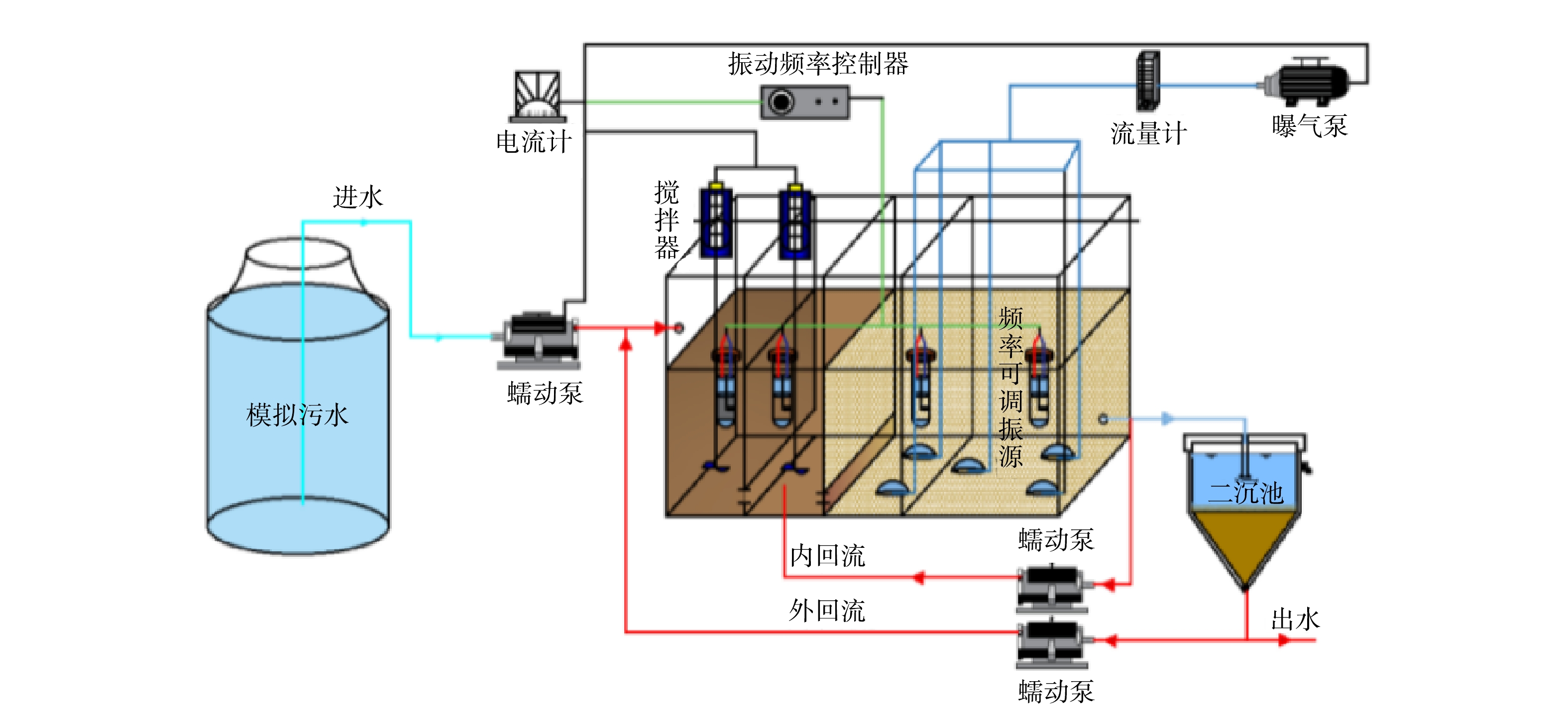
 下载:
下载:
